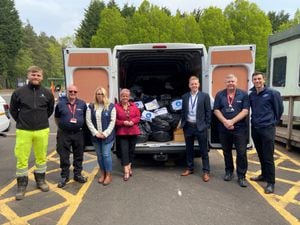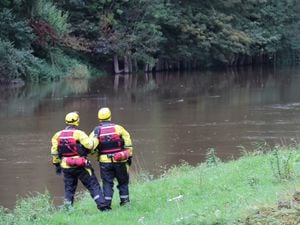'Stay out of flood water' – fire service warning after another Shropshire driver becomes stranded
Another driver found themselves trapped by floodwater in Shropshire in the early hours of Monday.

Shropshire fire and rescue service received a 999 call for help from a motorist just after 5.30am after their vehicle got stuck in the floods on a road at Edgerley, north of Shrewsbury.
Three fire appliances were mobilised from Baschurch, Oswestry and Shrewsbury including the water rescue unit.
A spokesperson for the fire service said that the driver of the car, stranded in floodwater, managed to get to safety prior to the arrival of firefighters. A paramedic also went to the scene.
West Midlands Ambulance Service said: "The man, who was already out of his vehicle, was assessed but was not injured and did not require hospital treatment so was given self-care advice and discharged at the scene."
Oswestry Fire Station went on to post advice for drivers on its social media.
"We are experiencing an increase in calls to vehicles stuck in shallow water. Do not enter floodwater in your vehicle," it said.
"If the worst happens and your car gets stuck in deep water stay inside it and phone for help. Don’t get out or open the bonnet or you could worsen the initial damage. Don’t try to restart the engine either as that could push water into it." It offered the following advice:
1. Take an alternative route
Never drive through deep, fast-flowing water and don’t drive through flooded roads if you can avoid them. It’s better to add an extra 10-15 minutes to your journey rather than risk your car’s engine and electrics being ruined, or even worse, the vehicle being swept away.
2. Check the water depth
If you have a pair of wellies handy you could wade into the water to see how deep it is (keep a powerful torch in the glovebox for use after dark), or you could park up nearby and watch other vehicles go though it first. Unless you’re driving a high-riding 4x4 or SUV, the maximum depth most experts advise you drive a standard car through is 10cm. Modern cars are generally water-tight so they can start to float when driven through water that’s only 30cm deep.
3. Let oncoming vehicles pass
Wait for oncoming vehicles to get through the flood patch before you head into it, especially if they’re larger vehicles or are travelling fast, because they could soak your vehicle and cause it to break down.
4. Drive along the highest point of the road
Most roads dip down at either side, so aim to drive in the middle of the road. That’s another reason to wait for oncoming cars to get out of the way before attempting to cross floodwater.
5. Don’t drive too fast
Drive through flood water slowly 3-4mph is an adequate speed. If you drive too fast you'll not only create a wave that’ll splash other road users, but you’ll also run the risk of your car’s tyres losing their contact with the road. If this happens, don’t brake, just take your foot off the accelerator and keep the steering wheel straight and wait for the grip to return.
6. Don’t stop
Although you should drive slowly, it’s important not to let the car come to a halt while crossing deep water because that could allow water to get into the exhaust pipe, which can cause costly damage. Keep the engine revs up, too; if necessary slip the clutch to do this in a car with a manual gearbox. If you’re driving a car with an automatic gearbox, select the lowest possible held gear and keep your foot on the accelerator.
7. Dry your car’s brakes
Gently press your car’s brakes a few times once you’re clear of the flood – and in a safe place to do so – to dry them off and ensure they respond efficiently.





